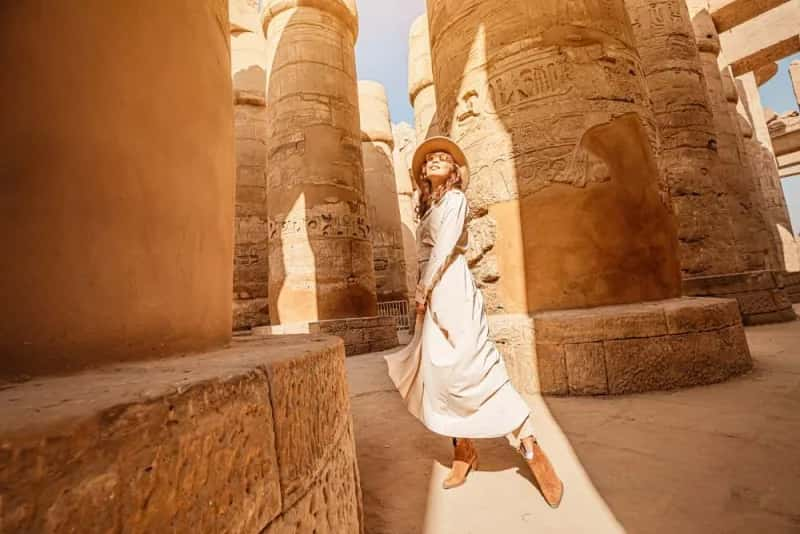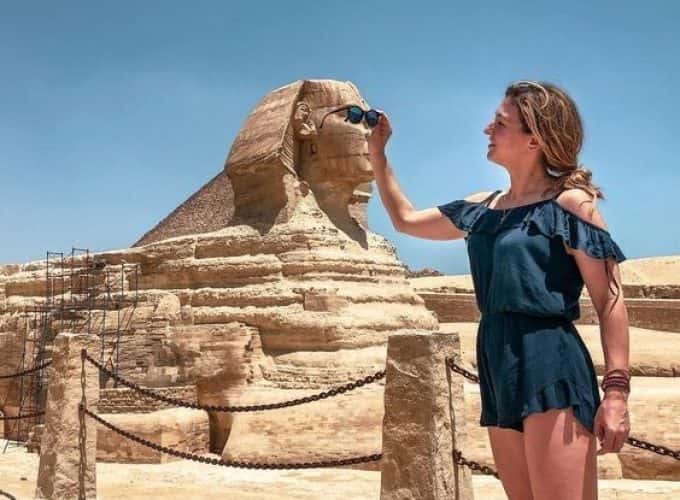
The Pyramids of Giza, Egypt's monumental tombs for Pharaohs Khufu, Khafre, and Menkaure, stand as the last of the Seven Wonders of the ancient world. Have you ever wondered what is inside the pyramids of Giza or what does the inside of a pyramid look like?
This article will unveil what's inside the pyramids, from their design and layout to the discoveries and artifacts that lie within. Join us as we explore the ancient secrets hidden inside these architectural wonders.
Materials and Methods
Workforce and Community
Construction Timeline and Techniques
Architectural Significance
This detailed look into the construction of the Pyramids of Giza reveals not only the complexity and scale of this ancient endeavor but also the sophisticated society that achieved it. The integration of engineering, labor management, and symbolic significance in the pyramids' construction continues to fascinate historians and engineers alike.
The Pyramids of Giza were primarily constructed as monumental tombs for the pharaohs, serving both religious and political purposes. These structures were intricately designed to ensure the continuation of the pharaoh's life force and to affirm the enduring nature of their divine kingship.
Purpose and Significance
Design and Construction
The construction of the Pyramids of Giza was a multifaceted endeavor that intertwined religious beliefs, political power, and architectural innovation, making them not only tombs but also lasting symbols of ancient Egyptian civilization.
Exploring the interiors of the Great Pyramid, the Pyramid of Khafre, and the Pyramid of Menkaure reveals a fascinating array of chambers, passages, and artifacts, each contributing to our understanding of ancient Egyptian engineering and burial practices. Here we delve into the specific features and contents found within these monumental structures.
Interior Chambers and Passages
The Great Pyramid (Khufu):
Pyramid of Khafre:
Pyramid of Menkaure:
Antechamber: Contains a wooden coffin inscribed with Menkaure's name and bones of a young woman.
Sarcophagi and Statues: Includes the Dyad Statue of Menkaure and his queen, showcasing royal power.
Artifacts and Discoveries
Scan Pyramids Project:
The interior of the pyramids, while austere with no decorations or inscriptions, holds significant historical and archaeological value, offering profound insights into the civilization's architectural prowess and cultural practices. Visitors today can explore these ancient passageways, experiencing the wonder of the pharaohs' final resting places.
Precision in Design and Construction
Astronomical Alignment:
The Great Pyramid was meticulously aligned with true north, deviating by only 1/15th of a degree. This precision highlights the ancient Egyptians' advanced understanding of astronomy and its importance in pyramid construction.
Dimensions and Materials:
The Great Pyramid stood originally at 481 feet and was constructed with about 2.3 million blocks. These included 5.5 million tonnes of limestone, 8,000 tonnes of granite, and 500,000 tonnes of mortar, showcasing the enormity and the detailed planning involved in its construction.
Advanced Architectural Features
North Face Corridor:
Recently discovered using modern technology, this corridor measures 30 feet and includes five chambers. It plays a crucial role in managing the structural integrity of the pyramid by distributing the pressure.
Innovative Use of Technology:
The discovery of the North Face Corridor was achieved without disturbing the pyramid's structure, demonstrating the integration of cutting-edge technology in archaeological methods. This approach preserves the integrity and historical value of the site while allowing deeper exploration.
These elements of design and layout not only underscore the architectural genius of the ancient Egyptians but also their ability to integrate functionality with grandeur, ensuring the longevity and stability of their monumental creations.
Intriguing Findings in the Pyramid of Menkaure
The Pyramid of Menkaure, although the smallest among the three major pyramids at Giza, holds significant discoveries that contribute to our understanding of ancient Egyptian burial practices and royal symbolism. One of the most notable findings within this pyramid is its antechamber, which was uncovered to contain artifacts of profound historical importance.
Antechamber Discovery:
The Wooden Coffin:
Human Remains:
These findings within the Pyramid of Menkaure not only enhance our knowledge of the burial customs but also provide a glimpse into the personal and ceremonial life connected to one of Egypt's ancient rulers. The artifacts found here, from the inscribed coffin to the human remains, each add a layer to the story of Menkaure, reflecting the complex interplay of culture, religion, and royalty in ancient Egyptian society.
Protecting the Legacy
The Pyramids of Giza, recognized for their historical significance and architectural brilliance, face challenges from urban encroachment, pollution, and illegal activities. In response, UNESCO inscribed these ancient marvels into the World Heritage List in 1979, initiating efforts to restore the Sphinx and manage local urban development effectively.
Technological Advances in Archaeology
Non-Invasive Exploration Techniques:
The ScanPyramids project, launched in 2015, employs advanced non-invasive methods such as infrared thermography and ultrasound to study the pyramids without causing physical damage.
This approach allows researchers to explore internal structures and hidden chambers, enhancing our understanding while preserving the site's integrity.
Digital Innovations:
The Giza Project at Harvard University integrates a vast array of data, from archaeological records to 3D reconstructions, providing a comprehensive digital platform for both educational and research purposes.
Tools like the Multilingual Egyptological Thesaurus offer valuable resources for academic study, making the extensive data about the Giza Plateau more accessible.
Collaborative International Efforts
A notable collaboration between Egyptian and Japanese archaeologists focuses on the Pyramid of Menkaure, aiming to document and restore its granite blocks. This partnership underscores the global importance of preserving such heritage sites.
Impact on Tourism and Education
Authorities leverage these archaeological discoveries to boost tourism, a vital source of revenue for Egypt. Educational initiatives like Giza @ School utilize the site's rich history to develop engaging learning materials for students worldwide.
By harnessing modern technology and fostering international cooperation, these explorations not only protect the pyramids but also expand our knowledge of ancient Egyptian civilization.
Conclusion
Through this exploration of the Pyramids of Giza, we have delved into the architectural marvels and ancient secrets hidden within their stone walls. From the innovative construction techniques and materials employed to the profound significance these structures held for the ancient Egyptians, both as tombs for eternity and as symbols of divine power, the pyramids stand as a testament to the civilization's advanced understanding of engineering, astronomy, and religious belief. The artifacts and chambers discovered within reveal much about the life, death, and afterlife in ancient Egyptian culture, offering invaluable insights into one of history's most fascinating societies.
The ongoing modern explorations, bolstered by technological advancements and international collaborations, continue to unravel the mysteries of the pyramids, fostering a greater appreciation for their historical and cultural legacy. These efforts not only ensure the preservation of this world heritage site for future generations but also deepen our understanding of the complexities of the ancient Egyptian civilization. As we reflect on the pyramids' enduring legacy, they remind us of humanity's persistent quest for knowledge, the power of collective endeavor, and the deep-seated human desire to connect with the divine.
Recent explorations inside the Great Pyramid of Giza have uncovered intriguing hidden features. In 2016, scientists employed muon imaging technology to detect a concealed corridor behind the chevron blocks on the pyramid's north face. The following year, they discovered a mysterious void elsewhere in the pyramid, which might possibly be an undiscovered chamber.
Inside the pyramids, particularly the Great Pyramid of Giza, hidden elements have been found, such as a secret corridor and a large void. The purpose of these spaces remains a subject of speculation, with some suggesting they could be additional burial chambers or serve other unknown functions.
The massive void discovered within the Great Pyramid of Giza is a sealed room, untouched since the pyramid's completion around 4,500 years ago. Its purpose is not yet understood, but it is speculated that it might be a secret burial chamber for Pharaoh Khufu, who commissioned the building of this pyramid.
Yes, the pyramids are believed to contain undiscovered secrets. While some chambers are accessible to scientists and tourists, other areas remain out of reach. To explore these hidden parts without causing damage, scientists use advanced imaging technologies that enable them to "see" behind the walls, leading to the discovery of previously unknown passages and spaces within the pyramids.
Read Also:
Cairo Egyptian Museum Of Egyptian Antiquities
“In my opinion, I believe a good writer makes content easy to read, and entertains the reader, making comprehension effortless.
By Kate Clark.webp.webp&w=3840&q=60)
Discover Egypt with this exclusive five-day Cairo and Luxor tour. Experience the Egyptian history by visiting pyramids a ...
$ 589 | Per Person

Book this Egypt Budget Tour and enjoy 8 days Cairo and Nile cruise tour package at the best price with 5 star quality ac ...
$ 1139 | Per Person
-1.webp.webp&w=3840&q=60)
This Egypt Itinerary 8 Days Cairo and Nile cruise package is the best Egypt tour travelers book. Visit the best of Egypt ...
$ 1299 | Per Person
.webp.webp&w=3840&q=60)
Book this 11 day Egypt tour package with a 7-day Nile cruise included, and visit the most emblematic tourist attractions ...
$ 1549 | Per Person
.webp.webp&w=3840&q=60)
The best Egypt Vacation Package: 11 day Egypt Trip Package. Starting by ancient Cairo, Cruising the Nile then relax on t ...
$ 2199 | Per Person

Join an incredible Egypt Christmas Tour to discover the enchanting wonders of Egypt during the festive season. This spec ...
$ 1599 | Per Person

Celebrate Christmas 2023 & New Year 2024 with this Egypt New Year Tour that brings you to all of the most exciting attra ...
$ 2599 | Per Person
.webp.webp&w=3840&q=60)
This 12 Day Cairo, Nile Cruise, Sharm El Sheikh tour in Christmas and New Year is the best option for you visiting the t ...
$ 2699 | Per Person

A romantic Egypt Honeymoon Trip. Visit the Pyramids and Sphinx with Nile cruise adventure in Luxor and Aswan watching li ...
$ 999 | Per Person

if you want to spend New Years in Egypt This 8-day Cairo and Nile cruise package is one of the best Egypt new year offer ...
$ 1799 | Per Person

This is the best offer among all Egypt Honeymoon Packages, Cairo, Nile Cruise and Hurghada 11 day romantic trip. Book To ...
$ 2199 | Per Person